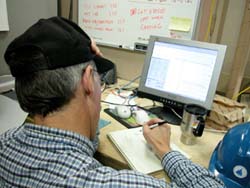CTD operations have resumed, despite some minor equipment malfunctions. We began with the deepest cast we have done yet -- to 2200 meters (over 7200 feet!). As the CTD progresses to the bottom, we pay close attention to the changing water temperature and salinity (saltiness). Then as the CTD is raised, we close the Niskin bottles to capture water samples at depth levels where certain water masses are located. Once the CTD is brought back on deck, we fill small sample bottles with water from each Niskin bottle. On this cruise we are analyzing both the nutrients and the salinity. Aaron Morello determines the amount of nutrients in the water samples using his nutrient analyzer (see Dispatch 04). Jim Schmitt measures the salinity of each sample as well. The salinity bottle data are important because they tell us if the measurements from the CTD are accurate. If there is a difference, the bottle measurements are used to adjust, or calibrate, the electronic measurements from the CTD. The coming week will be a very busy one for the science crew as we will attempt to deploy two moorings per day and run closely spaced (3 miles apart) CTD casts overnight.
 |
 |
|
Tom Weingartner chooses the depths where water samples will be collected.
|
|
Click to enlarge |
We all have our eyes on the weather, which appears to change by the hour. I will occasionally peer through a porthole and see brilliant sunshine reflecting off of the ice, but by the time I make it outside with my camera gear, it’s overcast and snowflakes are swirling around the deck! We have our fingers crossed, hoping the weather remains calm. If the winds pick up, it’s possible we could find ourselves back in the thick soupy ice we have just evaded.
If you have any questions about arctic oceanography or life aboard the Polar Star, send an email to arcticedge@whoi.edu.
 Previous Dispatch
Next Dispatch
Previous Dispatch
Next Dispatch

Back to Calendar




